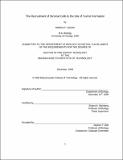| dc.contributor.advisor | Robert A. Weinberg. | en_US |
| dc.contributor.author | Saelzler, Matthew P. (Matthew Paul) | en_US |
| dc.contributor.other | Massachusetts Institute of Technology. Dept. of Biology. | en_US |
| dc.date.accessioned | 2010-08-26T15:13:52Z | |
| dc.date.available | 2010-08-26T15:13:52Z | |
| dc.date.copyright | 2009 | en_US |
| dc.date.issued | 2010 | en_US |
| dc.identifier.uri | http://hdl.handle.net/1721.1/57520 | |
| dc.description | Thesis (Ph. D.)--Massachusetts Institute of Technology, Dept. of Biology, February 2010. | en_US |
| dc.description | This electronic version was submitted by the student author. The certified thesis is available in the Institute Archives and Special Collections. | en_US |
| dc.description | Cataloged from student submitted PDF version of thesis. Vita. | en_US |
| dc.description | Includes bibliographical references. | en_US |
| dc.description.abstract | Myofibroblasts are an alpha-smooth muscle actin ([alpha]-SMA)-expressing cell type found within human mammary carcinomas, but not in the normal mammary gland. Myofibroblasts can enhance tumor formation by promoting angiogenesis and invasion, and we therefore sought to better understand how myofibroblasts are incorporated into breast carcinomas. By identifying secreted factors that recruit myofibroblasts as well as the physical niche where they originated, we aimed to identify possible therapeutic targets to inhibit their incorporation. Using a newly developed mammary carcinoma model, termed BPLER, we identified CXCL1, VEGF, CCL5, and IL-6 as factors that may be important for the recruitment of myofibroblasts. We tested the ability of CXCL1, VEGF164, or CCL5 to affect tumor formation and induce the incorporation of a-SMApositive cells. We show that the expression in MCF-7-Ras modified human breast cancer cells of VEGF164, but not CXCL1 or CCL5, results in the promotion of primary tumor growth and the increased incorporation of [alpha]-SMA-positive cells. Furthermore, we demonstrate that these a-SMA-positive cells do not correlate with cells expressing CD34, a marker of endothelial cells, suggesting that these cells are not [alpha]-SMA-positive smooth muscle cells. Thus, we propose that VEGF is a critical factor that recruits myofibroblasts to the site of breast cancer formation. In another line of experiments, we examined the source of the [alpha]-SMA-positive cell population recruited to another mammary tumor model, termed BPHER-3. | en_US |
| dc.description.abstract | (cont.) In order to investigate whether these cells are derived from the bone marrow, we utilized chimeric mice that express green fluorescent protein (GFP) in their bone marrow and blood cells in order to look for incorporation of GFP-labeled cells within the stroma of a subcutaneously grown tumor. We demonstrated that green bone marrow-derived cells are robustly recruited to the site of BPHER-3 tumor formation; however strikingly, almost 100% of the [alpha]-SMA positive cells analyzed were GFP negative. Our results demonstrate that the [alpha]-SMA-positive cell population recruited to BPHER-3 tumors is not bone marrow-derived, but is instead recruited from the adjacent tissue microenvironment. | en_US |
| dc.description.statementofresponsibility | by Matthew P. Saelzler. | en_US |
| dc.format.extent | 148 p. | en_US |
| dc.language.iso | eng | en_US |
| dc.publisher | Massachusetts Institute of Technology | en_US |
| dc.rights | M.I.T. theses are protected by
copyright. They may be viewed from this source for any purpose, but
reproduction or distribution in any format is prohibited without written
permission. See provided URL for inquiries about permission. | en_US |
| dc.rights.uri | http://dspace.mit.edu/handle/1721.1/7582 | en_US |
| dc.subject | Biology. | en_US |
| dc.title | The recruitment of stromal cells to the site of tumor formation | en_US |
| dc.type | Thesis | en_US |
| dc.description.degree | Ph.D. | en_US |
| dc.contributor.department | Massachusetts Institute of Technology. Department of Biology | |
| dc.identifier.oclc | 615595326 | en_US |
